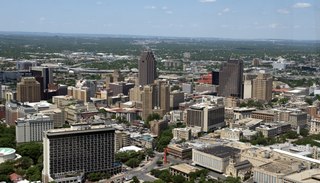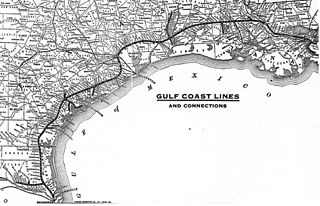
The Denver and Rio Grande Western Railroad, often shortened to Rio Grande, D&RG or D&RGW, formerly the Denver & Rio Grande Railroad, was an American Class I railroad company. The railroad started as a 3 ft narrow-gauge line running south from Denver, Colorado, in 1870. It served mainly as a transcontinental bridge line between Denver and Salt Lake City, Utah. The Rio Grande was also a major origin of coal and mineral traffic.

BNSF Railway is the largest freight railroad in the United States. One of six North American Class I railroads, BNSF has 36,000 employees, 33,400 miles (53,800 km) of track in 28 states, and over 8,000 locomotives. It has three transcontinental routes that provide rail connections between the western and eastern United States. BNSF trains traveled over 169 million miles in 2010, more than any other North American railroad.

The Kansas City Southern Railway Company was an American Class I railroad. Founded in 1887, it operated in 10 Midwestern and Southeastern U.S. states: Illinois, Missouri, Kansas, Oklahoma, Arkansas, Tennessee, Alabama, Mississippi, Louisiana and Texas. KCS had the shortest north-south rail route between Kansas City, Missouri, and several key ports along the Gulf of Mexico.

Kansas City Southern (KCS) was a transportation holding company with railroad investments in the United States, Mexico, and Panama that existed from 1887 to 2023. The KCS rail network included about 7,299 miles (11,747 km) of track in the U.S. and Mexico.

South Texas is a region of the U.S. state of Texas that lies roughly south of—and includes—San Antonio. The southern and western boundary is the Rio Grande, and to the east it is the Gulf of Mexico. The population of this region is about 4.96 million according to the 2017 census estimates. The southern portion of this region is often referred to as the Rio Grande Valley. The eastern portion along the Gulf of Mexico is also referred to as the Coastal Bend.

The Missouri Pacific Railroad, commonly abbreviated as MoPac, was one of the first railroads in the United States west of the Mississippi River. MoPac was a Class I railroad growing from dozens of predecessors and mergers. In 1967, the railroad operated 9,041 miles of road and 13,318 miles of track, not including DK&S, NO&LC, T&P, and its subsidiaries C&EI and Missouri-Illinois.

Kansas City Southern de México, S.A. de C.V. was a Mexican railroad and operating subsidiary of Kansas City Southern (KCS). The company was founded in 1996 as Transportación Ferroviaria Mexicana, a joint venture between KCS and Transportación Maritima Mexicana after the companies won a concession from the Mexican government to operate the 5,335-kilometer (3,315 mi) Northeast Railroad connecting Monterrey and Mexico City with a US port of entry at Laredo, Texas and seaports at Lázaro Cárdenas and Veracruz. In 2005, KCS bought out its partner's shares in the railroad, giving it full control.

The Corpus Christi Terminal Railroad was a terminal railroad originally created in 1924 to facilitate heavy bulk freight cargo traffic flow from the recently completed deep water port channel of the new Corpus Christi Port. Wishing to maximize freight handling potential while holding down rates, the Port Authority decided to allow traffic to all of its docks and facilities by no less than three competing railroads, the Southern Pacific, the Missouri Pacific and the Tex-Mex railroads. To accomplish this the Port of Corpus Christi Authority built its own trackage along the channel and to the docks, and allowed all three carriers access to it. While the Authority's scheme at first heightened tensions among the three railroads, they eventually began to cooperate, assuring a good flow of bulk freight and the eventual success of the Port facilities.

The Texas Mexican Railway International Bridge is an international railway bridge across the Rio Grande and U.S.-Mexico border between Laredo, Texas, and Nuevo Laredo, Tamaulipas, the only rail link between these cities. Owned and operated by CPKC, the single-track bridge is the busiest rail border crossing in North America. It is also known as the Laredo International Railway Bridge and Puente Negro.

Chartered on June 6, 1903, the St. Louis, Brownsville & Mexico Railway was a 200-mile (321 km) U.S. railroad that operated from Brownsville, Texas, to Gulf Coast Junction in Houston, Texas. It served numerous towns and cities along its routes and operated a rail bridge between Brownsville and Matamoros, Tamaulipas, in junction with the Mexican government. The Brownie connected the citizens of Brownsville to nearby Corpus Christi for the first time on land rather than using water transportation.

The Gulf Coast Lines was the name of a railroad system comprising three principal railroads, as well as some smaller ones, that stretched from New Orleans, Louisiana, via Baton Rouge and Houston to Brownsville, Texas. Originally chartered as subsidiaries of the Frisco Railroad, the system became independent in 1916 and was purchased by the Missouri Pacific Railroad in 1925.
The San Antonio and Aransas Pass Railway first began operation in the U.S. state of Texas in 1886. It was developed by Uriah Lott and businessmen of San Antonio as a direct route from the city to Aransas Bay on the Texas Gulf coast. It was eventually absorbed in the 20th century by Southern Pacific.
The Rio Grande Valley League was a minor league baseball league, with franchises based exclusively in Texas. The Rio Grande Valley League had two incarnations, playing in 1931 and 1949 to 1950.
The Donna Cardinals were a minor league baseball team based in Donna, Texas. In 1949 and 1950, Donna based teams played exclusively as members of the Rio Grande Valley League. The 1950 Donna-Weslaco Twins played in partnership with neighboring Weslaco, Texas. Donna hosted minor league games at Avila Park.
The Texas and Oklahoma Railroad (TXOR), created in 1991, ran between Oklahoma and Texas on rail purchased from the Atchison, Topeka and Santa Fe Railway (AT&SF). Much of the trackage has since been sold or abandoned; however, the railway continues to exist as a shortline carrier operating between Sweetwater, Texas and Maryneal, Texas.
Uriah Lott (1842–1915) was an American engineer who worked on the development of railways. Lott, Texas, is named after him because of his role in bringing the railway through Falls County, Texas. While he was not originally from Texas, he made a large impact on the transportation system throughout the state.
The Robstown Rebels were a minor league baseball team based in Robstown, Texas in 1949 and 1950. Preceded by the 1949 Robstown Cardinals, the Robstown teams played exclusively as members of the Rio Grande Valley League, playing partial seasons in both years. Robstown hosted home minor league games at the Sun Sport Ball Park.

Canadian Pacific Kansas City Limited, doing business as CPKC, is a Class I railroad in North America that resulted from the merger of Canadian Pacific Railway (CP) and Kansas City Southern (KCS) on April 14, 2023. It is the first and currently the only single-line railway connecting Canada, Mexico, and the United States, operating approximately 32,000 kilometres (20,000 mi) of rail across the three countries. CPKC is headquartered in Calgary and led by Keith Creel as President and CEO.

Laredo station is a former Amtrak and Missouri Pacific passenger train depot in Laredo, Texas. The station was the southern terminus of the Inter-American, the last Amtrak train to serve Laredo, which ran from 1973 to 1981.













